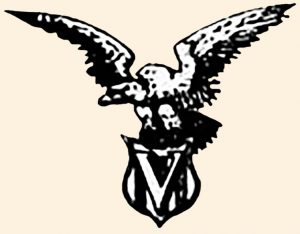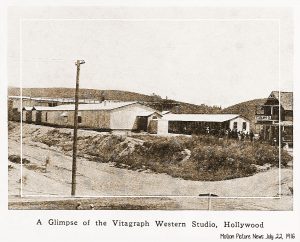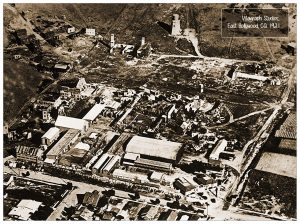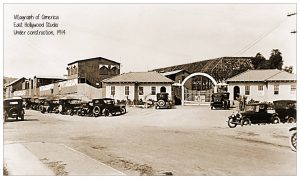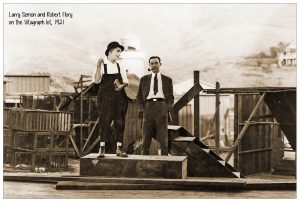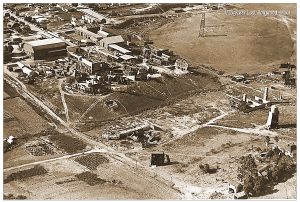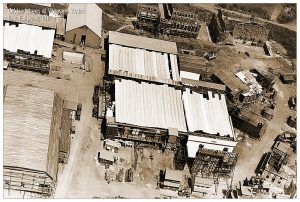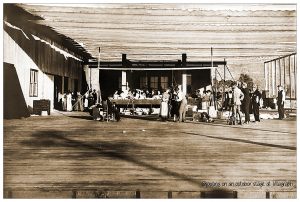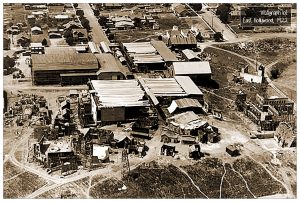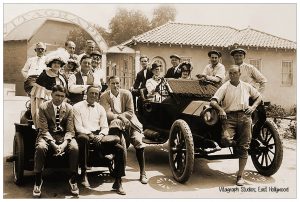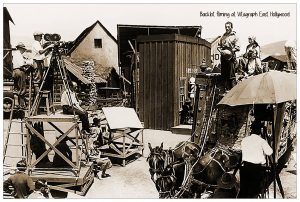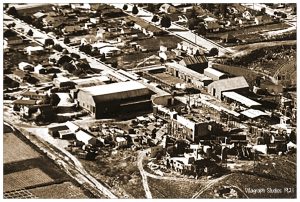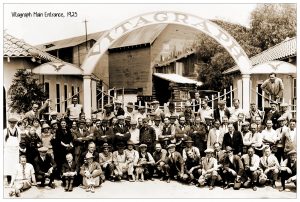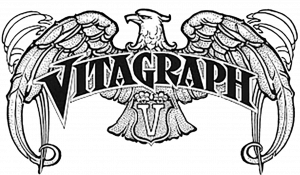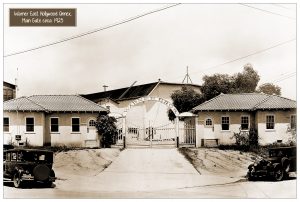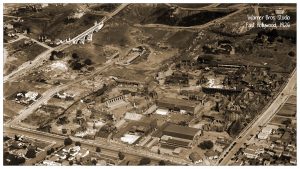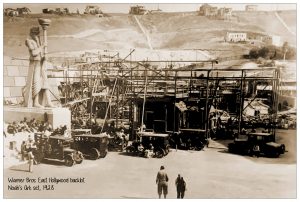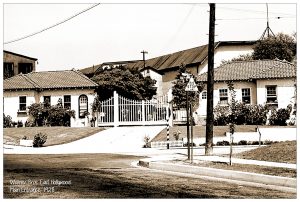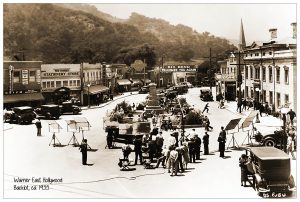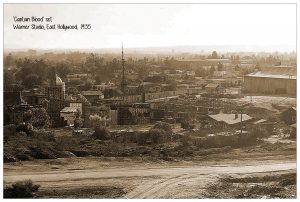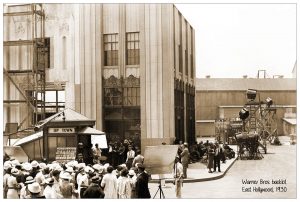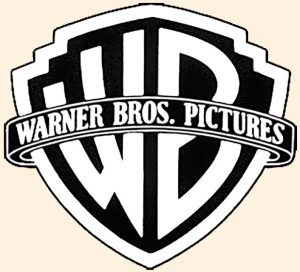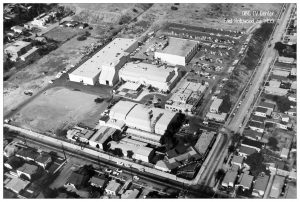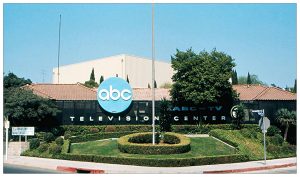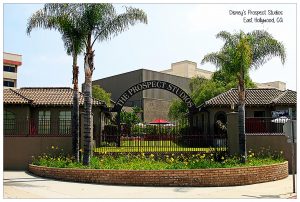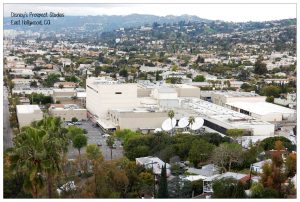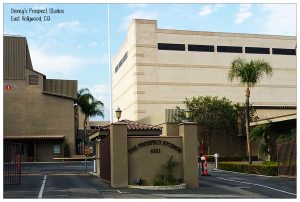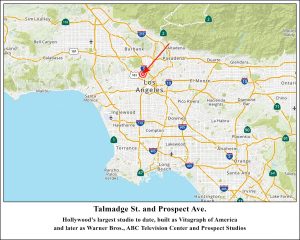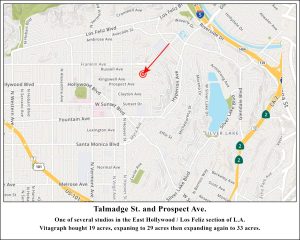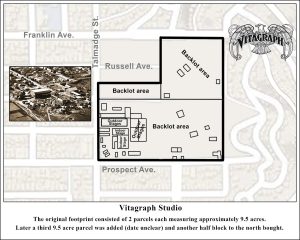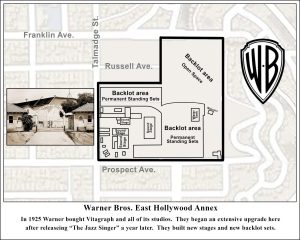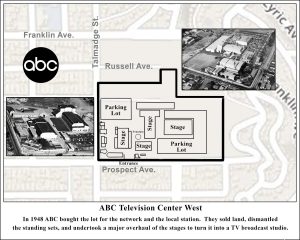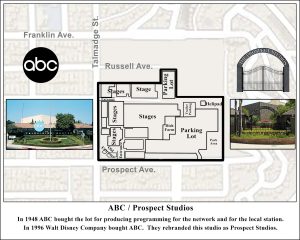Vitagraph, Warner Bros., ABC, Disney
Talmadge Ave. and Prospect St.
East Hollywood's largest studio, and still going strong
known by two addresses: 1708 Talmadge St., and 4151 Prospect Ave.
Photo courtesy of Marc Wanamaker / Bison Archives click to enlarge

Vitagraph Studios
Vitagraph of America
1708 Talmadge St.
Active 1915-1925
J. Stuart Blackton and Albert E. Smith were among the original movie moguls, starting their business, American Vitagraph Company, in 1897. In 1899 a third partner, William T. "Pop" Rock joined the firm.
After bouncing around a few studio locations, they built a very large studio in Brooklyn in 1906. Vitagraph Studio in Brooklyn was the first large, modern movie studio and by 1907 they were the largest movie company in the country from their 3.5 acre studio in Flatbush, Brooklyn.
They wanted to produce the very popular Westerns but Brooklyn was just not the place. So, westward they went in search of a suitable spot. After a brief stop in Colorado they set up shop in Santa Monica, CA.
The company built an indoor stage and several outdoor stages, extensive backlot with standing sets covering various places and periods of time. There was enough space to make any kind of movies they chose shooting several at one time. By 1919 all of the production company had relocated from Brooklyn to Hollywood. They employed nearly 500 people at the peak.
In 1911 they built a small studio in Santa Monica to give them a foothold and in 1915 they built their permanent West Coast home in East Hollywood. (sitting on the cusp of the Los Feliz and East Hollywood neighborhoods of Los Angeles).
Construction began in earnest. According to records of the era, the lot sat on just over 19 acres of purchased land with another 9.5 of (what appears to be) leased land. The studio entrance sat a Talmadge and Prospect facing the corner with the driveway angling between two buildings, passing under an arch that read "Vitagraph."
Vitagraph expanded with more (leased) land to just over 33 acres. The property ran up to what is now known as the Shakespeare Bridge. Today it has shrunk to about 25 acres. The street running along the west edge of the studio had no name until Vitagraph bought the property when they named Talmadge St. for their biggest star, Norma Talmadge. As well, Russell Street, running along the north edge of the studio, was named for Vitagraph star William Russell.
Though much of the production was transferred to the Hollywood studio, having a bi-coastal presence cemented Vitagraph's place in the business until they sold the company to the up and coming Warner Bros.
Vitagraph's bread and butter in Hollywood were urban comedies and dramas, though they did shoot a few cowboy westerns. Their stars included not only Norma Talmadge, one of the country's biggest stars, but Larry Semon, a very popular comedic actor, Florence Turner (the "Vitagraph Girl" who was one of the first true movie stars), Maurice Costello, brother-in-law of John Barrymore, and Costello's sister, Dolores Costello, Barrymore's wife, Wallace Beery, and Anita Stewart, Hedda Nova, Antonio Moreno, Corrine Griffith, Alice Joy, and many, many others.
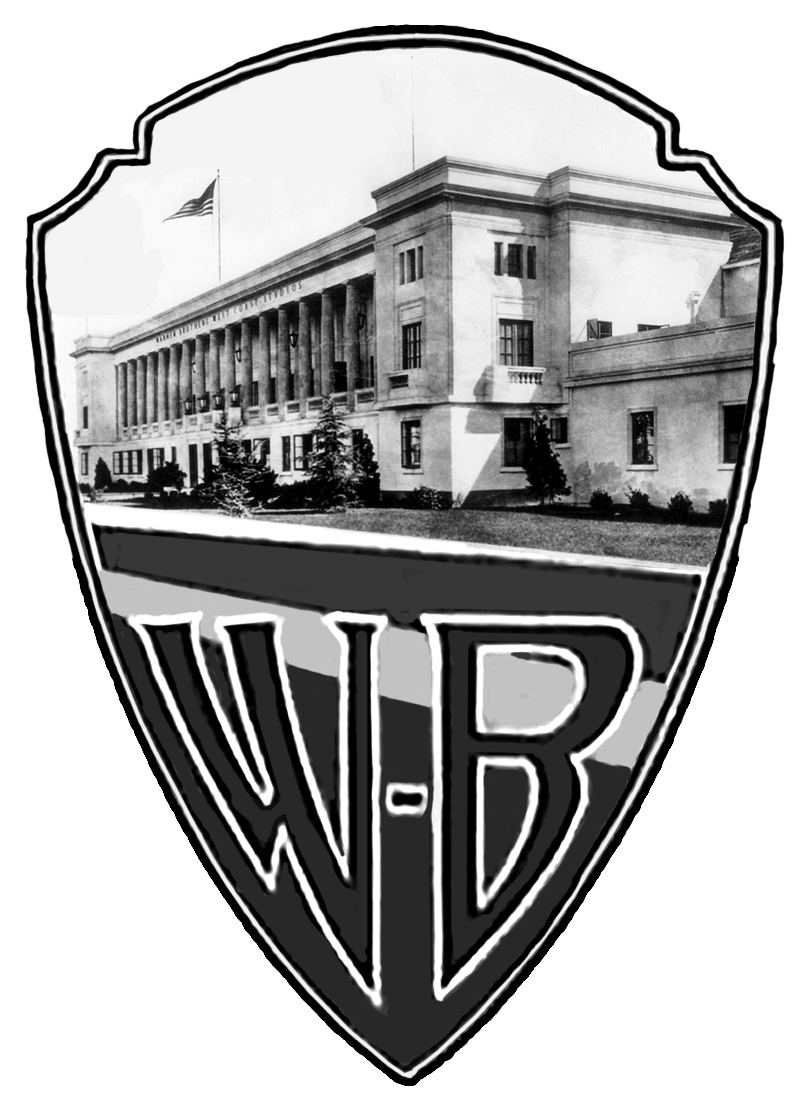
Warner Bros. Studio
Warner Bros. Studio
1708 Talmadge St.
Active 1925-1948
On April 20, 1925 a blockbuster transaction was announced to the public. "Pioneer Vitagraph Sold to Warner." "Announcement of Big Deal Comes As Surprise."
The Warner Brothers started producing movies during the latter part of the silent era. Most of the early original companies were out of business by the time WWI wrapped up. Warner Bros were just getting started.
Having dabbled in movie theaters, in 1904 the Warner Brothers, Harry, Albert, Sam, and Jack, opened a movie distribution business, Duquesne Amusement & Supply Company. During the first world war they began producing their own films. They bounced around, renting studios here and there until 1918 when they opened their first studio on Sunset Blvd. in Hollywood. Warner Bros. Studio had a single stage and some offices and dressing rooms. Growth was explosive for them but profitability was slower. Harry Warner's philosophy was that in order to be successful you had to look successful. So they set out to put up a great front.
They filled out the production area at the Sunset Blvd. studio and in 1925 the four brothers expanded by buying one of the oldest, best know, and most productive companies, The Vitagraph Company. Along with the purchase came two additional studios (one in Brooklyn, and this one in East Hollywood) and a fledgling sound-on-disc system called Vitaphone, and the pioneering movie maker, The Kalem Company, who assets Vitagraph bought in 1919.
This raised the brothers' profile in the business. They now had three studios, including this Talmadge Street lot which became known as the Warner Bros. East Hollywood Annex. In short order they started using the sound system producing "Don Juan" starring John Barrymore. The movie had a music and sound effects track recorded on a disc that was synchronized with the film. Only about 100 of the more than 20,000 nationwide theaters were equipped to show the movie. Despite that it was Warner's biggest grossing film to date.
Within a year they began work on "The Jazz Singer," the groundbreaking movie that heralded to the world the coming "Talkies" with the words "You ain't heard nothin' yet." Some of that movie was shot here at the Talmadge Street annex.
The huge financial success of these two films assured that the Warner Bros. name would be one we would never forget. It also allowed them to expand both the Sunset Blvd. studio and the East Hollywood Annex, as well as by First National Productions and its 110-acre studio in Burbank, which has become an iconic symbol of the movie business to this day.
At the East Hollywood lot, the company built a new huge enclosed stage, a water tank to shoot ocean scenes on the lot, and they expanded the backlot with new standing sets and streets. They expanded to 33 acres.
Stars at Warner Bros. included some of the biggest of the era: Al Jolson, Dolores Costello, George Arliss, Fannie Brice, Myrna Loy, Antonio Moreno (old Vitagraph star), John Barrymore, Monte Blue, Sophie Tucker, H. B. Warner, John Boles, and Noah Beery, and directors Roy Del Ruth, Michael Curtiz, Alan Crosland. Their biggest star may have been Rin Tin Tin. After the Burbank lot opened and talkies were in full swing, many of the Burbank contract players worked on the Talmadge lot: Bette Davis, Edward G. Robinson, Paul Muni, Errol Flynn, Olivia de Havilland, James Cagney, Guy Kibbee, Kay Francis, Fredric March, Pat O'Brien, and Ruby Keeler.
Throughout the 1940s the lot saw more use as a backlot than a studio, both by Warner and by others renting the facility. During the war years, it was used as a military training facility
In 1948 Warner Bros. sold the East Hollywood lot to the new ABC network.

ABC West Coast
ABC Television Center West
4151 Prospect Ave.
Active 1948-1996
On October 9, 1948, it was announced that the fledgling American Broadcasting Company was buying the old Warner East Hollywood as their West Coast broadcasting center and the home of their new television station, KECA (later KABC).
An FCC decision in 1942 required NBC (National Broadcast Company) to give up one of its two networks. Mutual Broadcasting (now defunct) sued NBC accusing them of using the second network as an anti-competition mechanism, and the FCC agreed. On October 12, 1943, Edward J. Nobel, already the owner of Life Savers and the Rexall Drugstores chain, consummated the deal to buy the NBC Blue Network and its 60 stations and affiliates. Based in New York City, by the end of the decade they were ready to expand westward.
The large backlot was demolished and, parts of the lot sold off, and the rest was leveled making ready for a new stage and parking lot construction. Stages were retooled for live broadcasting and upgraded to hold audiences. The cute front entrance on the corner was blocked off and the main entrance moved over to Prospect Ave.
ABC shot much of its television programming at this lot, including local news broadcasts, and many of the games shows and soap operas that were popular throughout the 50s, 60s, and 70s. They also shot 3 camera comedies in front of live audiences and other kinds of live programming. For other types of television programming, they leased studio space around the area.
In 1996 The Walt Disney Company bought ABC (after having previously bought ESPN). The lot transformed, in name only, to The Prospect Studios. The ABC west coast operation moved to Disney's main campus in Burbank and the local station to Disney's Grand Central Creative Campus in Glendale.
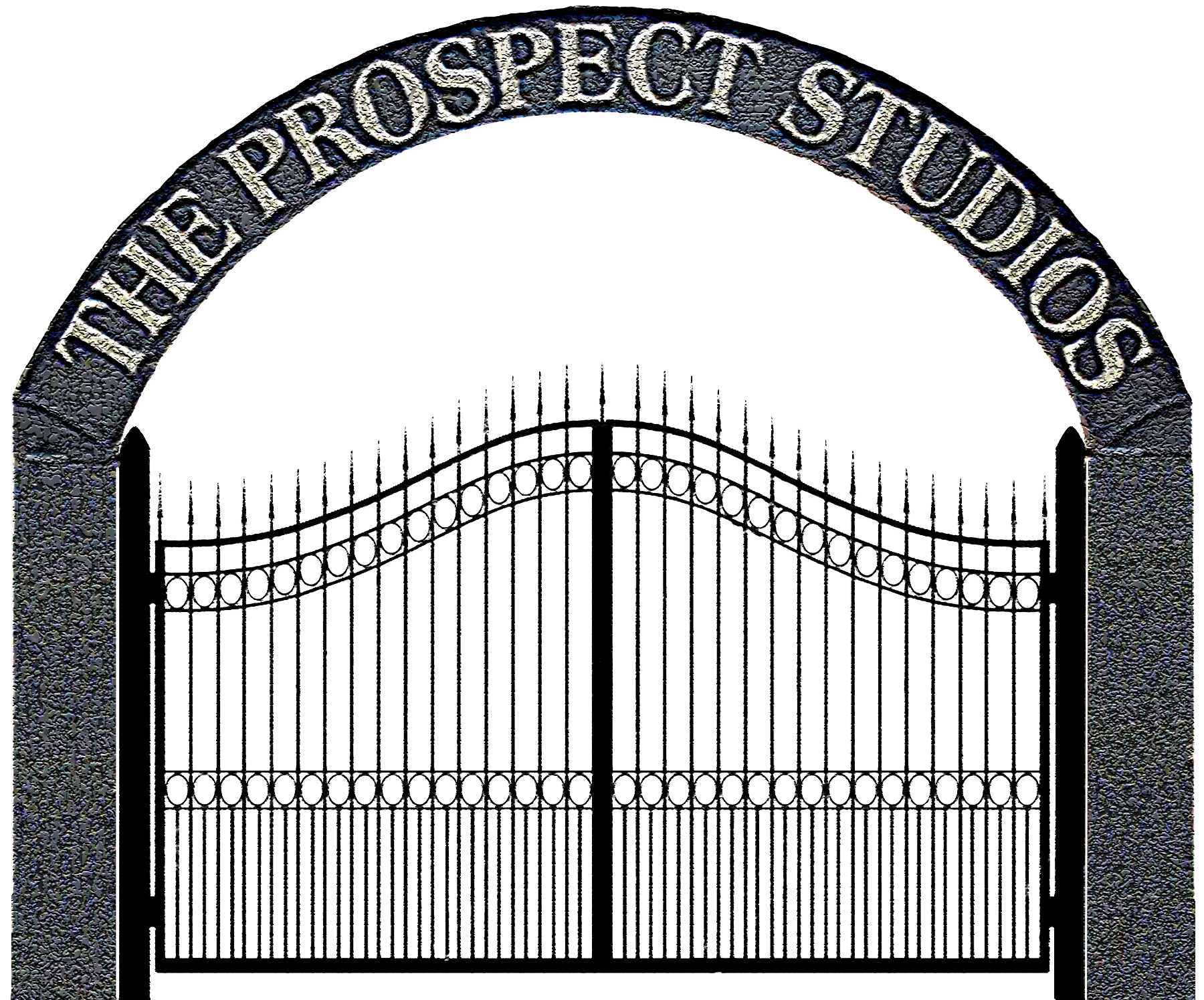
Disney's Prospect Studios
Prospect Studios
4151 Prospect Ave.
Active 1996-present
The association between ABC and Disney began as far back as the 1950s when ABC lent money to Walt to build Disneyland and Disney agreed to provide programming to ABC. The relationship culminated in the July, 1995 announcement that The Walt Disney company intended to buy ABC's parent company, Capital Cities, renaming the new subsidiary ABC, Inc. The merger was completed on February 9, 1996.
The new subsidiary was moved to the Walt Disney headquarters in Burbank while KABC was relocated to Disney's Grand Central Creative Campus in Glendale, a sprawling area spanning more than 10 redeveloped city blocks.
The Prospect Studios went through little more than a name change, replaced ABC signage with Prospect Studios signage, and the former ABC lot went on as normal, turning out programming for the ABC television network and the Walt Disney Company.
Photo Gallery of ABC and Prospect Studios
click any image to start slide show






